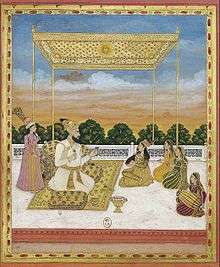Muhammad Khan Bangash
Nawab Ghazanfar-Jang, Muhammad Khan Bangash (1665 – 1743) laid the foundation of the Nawab of Farrukhabad in Uttar Pradesh, India and was sworn in as its first Nawab in 1715. He was a "Bawan Hazari Sardar" (Commander of 52000 Men Strong force) in the Mughal Army. He served as governor of Malwa and Allahabad provinces of Mughal empire.[1][2] He was also viceroy of Assam from 1735-1743.Although regarded as rude and illiterate he was well regarded for his loyalty, and it is believed that had fortune sided with him he would have been able to establish a kingdom rivalling the deccan or awadh.
| Nawab Muhammad Khan Bangash | |
|---|---|
| Nawab of Farrukhabad Nawab Of Allahbad Nawab Of Malwa Viceroy of Assam Sardar,Ghazanfar Jang | |
 Khan entertained by women | |
| Nawab of Farrukhabad | |
| Reign | 1713-1743 |
| Predecessor | Monarchy Established |
| Successor | Nawab Qaim Khan Bangash |
| Nawab Of Allahbad | |
| Reign | 1725-August 1729 and 1735-1736 |
| Predecessor | Sarbuland Khan |
| Successor | Sarbuland Khan |
| Nawab Of Malwa | |
| 25 October 1752 | 26 January 1731 |
| Predecessor | Girdhar Bahadur |
| Successor | Jay Singh Of Amber |
| Born | Muhammad Khan 1665 |
| Died | 1743 |
| Issue |
|
| House | Bangash |
| Father | Ain Khan Bangash |
| Religion | Islam |
| Occupation | Mughal Ispahsalar |
Background
Muhammad Khan belonged to khaghzai branch of Pashtun Bangash tribe. In India they were referred to as qaum-i-bangash. His father, Ain Khan Bangash had migrated from his native lands in the time of Aurangzeb and settled in Mau Rashidabad. Muhammad Khan gained a reputation as one of the most powerful of the Afghan mercenary warriors who inhabited that part of Hindustan, and eventually came to establish the territories that were consolidated into the state of Farrukhabad. The state of Farrukhabad was named after Muhammad Khan's patron the Emperor Farrukhsiyar.[3] At his death his dominions included the entire Doab from Koil in the North, to Kora in the South, including all of Farrukhabad and parts of Cawnpore, Shahjahanpur, Budaun and Aligarh.[4] His brother Himmat Khan Bangash was the father of Nawab Murtaza Khan of Jahangirabad, and the grandfather of the poet Nawab Mustafa Khan Shefta.[5]
Later Mughal-Maratha Wars
In Bundelkhand, Chhatrasal had rebelled against the Mughal Empire and established an independent kingdom. In December 1728, a Mughal force led by the distinguished commander Muhammad Khan Bangash attacked him, and besieged his fort with his family. Chhatrasal had repeatedly sought Peshwa Baji Rao's assistance, but the latter was busy in Malwa at that time.
In March 1729, the Peshwa Baji Rao I finally responded to Chhatrasal's request and marched towards Bundelkhand. Chhatrasal also escaped his captivity and joined the Maratha forces. After they marched to Jaitpur, as a result Bangash was forced to retreat from Bundelkhand. Chhatrasal's position as the ruler of Bundelkhand was restored.[6]
Nawabs
There were following Nawab of Farrukhabad
- Nawab Muhammad Khan Bangash
- Nawab Qaim-Jang Qaim Khan Qaim-ud-daula
- Nawab Ahmad Khan Bangash.-> He defeated the Marathas. (took part in the Third Battle of Panipat in 1761 alongside Ahmad Shah Abdali Baba)
- Nawab Muzaffar-Jang Daler Himmat Khan
- Nawab Nasir-Jang Imdad Hussain Khan
- Nawab Tafazzul Hussain Khan
References
- A history of the Bangash nawabs of Farrukhabad, from 1713 to 1771 A.D. by Jos J. L. Gommans
- The Rise of the Indo-Afghan Empire: C. 1710-1780 By Jos J. L. Gommans
- The Cambridge History of India Vol.IV. p. 353.
- "Mohammad Khan Bangash".
- "Ain Khan Bangash".
- G.S.Chhabra (1 January 2005). Advance Study in the History of Modern India (Volume-1: 1707-1803). Lotus Press. pp. 19–28. ISBN 978-81-89093-06-8.